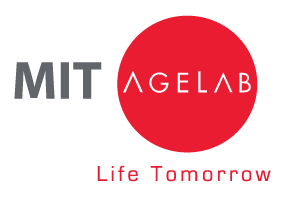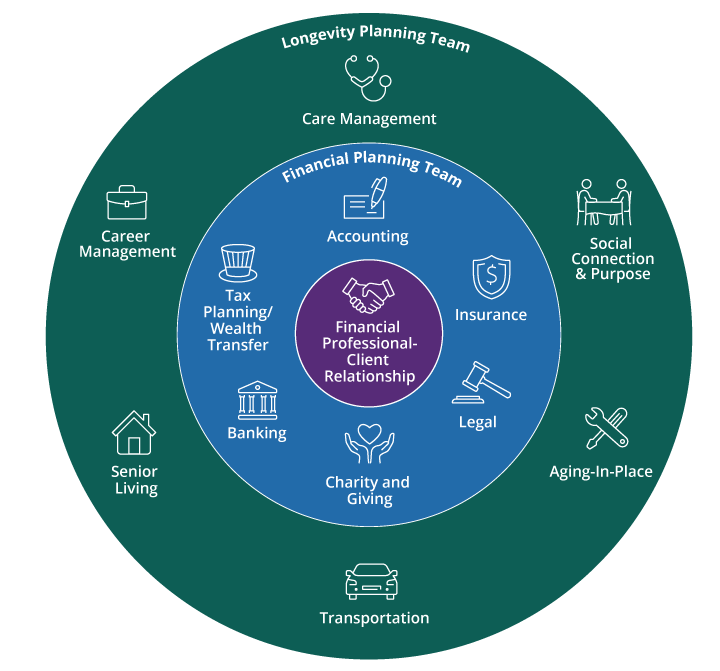For example, referrals often go back and forth between financial professionals and accountants. Lawyers provide guidance on trusts and estates; elder law attorneys are often a resource for financial professionals with clients facing a family member with cognitive impairment. Likewise, insurance agents and specialized tax services are routinely part of today’s financial planning team. The longevity network, however, builds upon the financial professional-client relationship and the established ring of financial- planning partners by adding a new team of experts and service providers. This new capacity enables the financial professional to engage, inform, plan, and serve the diversity of needs their clients will face as middle-aged adult children caring for elderly parents or as older adults living independently. Figure 1 identifies the following selected issues and prospective team partners for tomorrow’s longevity-planning financial professional.
The Longevity Network Categories
Care Management
At some point, most clients will provide care for a loved one managing poor health. Caregiving is an emotional and costly issue, and care management is very complex. Managing one or more health conditions is difficult enough; however, identifying home care providers or coordinating medical specialists can be overwhelming for even the best-educated and resourced client. Geriatric care managers are a valuable resource for navigating the complexities of caregiving and the healthcare system. Often coming from the ranks of nurses, social workers, or other care professions, geriatric care managers can serve as a client’s caregiving expert, assessing the safety of a parent’s home, coordinating care services, navigating a maze of hospital appointments, identifying community social services, and more.
Social Connection and Purpose
Retirement is a major life transition that often affects a client’s identity and sense of purpose. For some financial professionals, developing connections with volunteer organizations, social groups, and community organizations may be invaluable to clients attempting to develop a renewed sense of purpose or seeking their encore calling in life after full-time work.
Aging-In-Place
Most aging adults prefer to age in their own homes (75%) and communities (73%) where they've built memories and paid off their mortgages.1
To age in place, 43% of older adults realize they might need to make home modifications, like updating bathrooms or adding ramps. About 25% expect to add space for a loved one needing care or for guests.1
One reason is a client's home may not easily accommodate their changing physical needs. Master bedrooms on the second floor, bathrooms with narrow doors or difficult shower entrances, and kitchens with high cabinets are just a few potential barriers to aging independently in the home. Nationally certified aging-in-pace specialists (CAPS) can provide advice and alternatives that enable clients to stay at home, reducing the need for a costly move and the risks of a catastrophic accident.
Transportation
Transportation is the third-largest cost in retirement after housing and food.2 Few financial professionals see transportation as an issue for retirement planning, except when the client uses funds to buy a new car as a retirement reward. Given the increasing technological complexity of today’s new cars, connecting clients to automobile experts in a seminar can be both fun and engaging across the generations. Transportation can be a challenge for older Americans living in suburban and rural areas where alternatives to driving are limited. Driving rehabilitation specialists can assess driving ability, determine if any adaptive driving equipment is needed, determine if driver rehabilitation or training is needed, and identify transportation alternatives for those who no longer find driving a comfortable or safe option.
Senior Living
Like real estate, living well in retirement and older age is about location, location, location. But where to live may depend on a client’s preferences as well as physical health. Is downsizing the right choice? Relocating to a favorite vacation spot may be attractive, but it may not support aging or provide adequate access to transportation, friends, and healthcare. What if senior housing is the appropriate choice for an elderly parent or a client in advanced years? Identifying knowledgeable real estate agents who have helped downsizers and being able to recommend trusted senior housing providers are ways for financial professionals to aid in answering these questions.
Career Management
More people are choosing to work longer. A study found that among pre-retirees surveyed, 75% said they plan to work part-time in retirement.3 Some clients ay plan to continue in their current professions, but others may choose to change careers or even start a new business. Career-management professionals can be valuable sources of guidance for soon-to-retire clients or recently retired clients.
Summary
The longevity network places the financial professional at the center of the client’s longevity planning. Although the financial professional need not, and cannot be, an expert on all these issues, they can serve as a trusted guide who identifies future issues and coordinates access to an extensive range of expertise and services that respond to a client’s evolving needs throughout possibly 30+ years of retirement.
Providing client value in today’s longevity economy includes traditional financial services while also defining advisory value beyond economic security. At the most basic level, longevity-planning advice includes coordination of client-expert meetings and convening client longevity planning seminars with one or more experts.
Today’s financial professionals define their value too narrowly. Financial expertise is critical, but a combination of disruptive technologies and evolving client needs and expectations require a new type of advice. Tomorrow’s longevity-planning financial professionals will leverage the very technology that threatens their current practices to perform time-consuming financial management tasks, and then invest the time saved into developing deeper client relationships with new conversations and services. Financial professionals turned longevity-planning financial professionals will acquire a new generation of clients, deepen their relationship with existing clients, and greatly increase the probability of retaining family assets.









